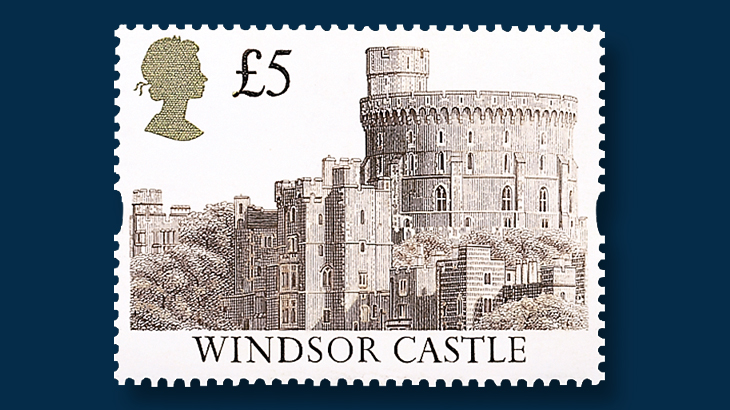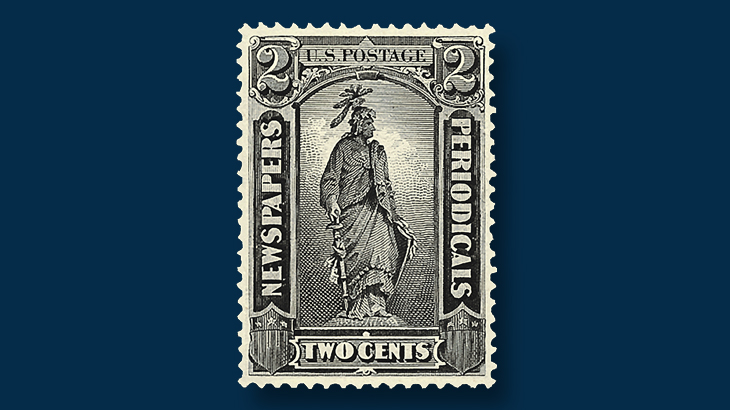US Stamps
Optically variable ink stamps arrive June 27
By Michael Baadke
The United States Postal Service will issue three high-denomination stamps June 27 that include intaglio printing plus a security element not previously seen on U.S. postage stamps.
The numeric denominations on the $1, $2 and $5 Statue of Freedom stamps will be printed with optically variable ink that appears to display different colors when the angle of viewing is altered.
The color-shifting ink is probably similar to what has been used in recent years to print some numeric denominations on U.S. currency in denominations of $10 and greater.
The “10” or “20” in the lower right corner on the front of a Series 2013 $10 or $20 bill, for example, is printed with optically variable ink.
Banknote Corporation of America is printing the three new stamps in a combination of offset and intaglio printing. Instead of employing a line engraving created in steel by an artist with an engraving tool, the Postal Service has recently reproduced digital designs mechanically for its intaglio stamps.
The three new stamps will be issued during an 11 a.m. first-day ceremony in Bellefonte, Pa., in association with the American Philatelic Society’s annual Summer Seminar on Philately, which is taking place June 24-29 at the American Philatelic Center.
The new stamps each feature the same illustration of the face on the statue of Freedom that stands at the top of the U.S. Capitol dome in Washington, D.C. The vignette on each stamp is printed in a different color: the $1 in emerald green, the $2 in indigo and the $5 in brick red.
The central illustration is based on a stamp vignette designed nearly 100 years ago by Clair Aubrey Huston of the U.S. Bureau of Engraving and Printing. That design was line engraved by John Eissler of the BEP and featured on the $5 carmine and blue Head of Freedom Statue stamp issued in 1923 (Scott 573).
On that earlier stamp, the name “AMERICA” is printed on a slightly arching banner directly below the portrait of the statue. That design was reproduced in 2006 as part of a set of three stamps commemorating the Washington 2006 World Philatelic Exhibition (Scott 4075).
“USA” is printed in a horizontal line below the numeral on each of the new stamps. Microprinting underneath the “USA” repeats the denomination in words five times in a horizontal line (as “FIVEFIVEFIVEFIVEFIVE,” for example). Below that is “DOLLARS” reading down vertically.
Postal Service art director Greg Breeding designed the new stamps. The $1 and $2 stamps will be issued in panes of 10, and the $5 stamp will be issued in a pane of four.
These new stamps will replace three stamps from two earlier sets: the $1 and $2 stamps from the Patriotic Waves issue of 2015 (Scott 4953-4954), and the $5 stamp from the 2012 Waves of Color issue (4719).
The $1 Patriotic Waves stamp is still available from the USPS Postal Store at https://store.usps.com, as is the $10 Waves of Color stamp.
Connect with Linn’s Stamp News:
Sign up for our newsletter
Like us on Facebook
Follow us on Twitter
The $2 Inverted Jenny stamp, issued in 2013 in a pane of six (Scott 4806), has not been taken off sale and is still available at some post offices.
Stamps with even-dollar denominations of $1, $2, $5 and $10 are usually kept in service to accommodate postal customers mailing heavier parcels or flats requiring postage that is not covered by a stamp with a dedicated denomination. The even-dollar denominations can be used in combination with other stamps to pay higher postage rates.
The statue of Freedom was designed by Thomas Crawford and cast in bronze. It was installed atop the Capitol dome on Dec. 2, 1863.
On the occasion of the statue’s 150th anniversary, Kathleen Wunderly researched its history and wrote about its numerous appearances on U.S. stamps and postal stationery for an article published in the Dec. 16, 2013, Linn’s Stamp News.
The first stamps to feature the statue were seven newspaper stamps issued Jan. 1, 1875 (Scott PR9-PR15). Wunderly’s article includes a list of U.S. stamps depicting the Capitol.
While the use of optically variable ink is new to U.S. stamps, it has been used before on stamps from other countries. The queen’s silhouette on Great Britain’s 1992-95 set of high-denomination Castle stamps, for example, is printed with optically variable ink that appears to change color from green to gold.
MORE RELATED ARTICLES
Headlines
-
US Stamps
Oct 7, 2024, 3 PMMcMurtrie dismissed as APS education director following Sept. 21 arrest
-
US Stamps
Oct 7, 2024, 12 PMVasiliauskas named president of Mystic Stamp Co.
-
US Stamps
Oct 6, 2024, 5 PMApgar souvenir card available
-
US Stamps
Oct 6, 2024, 4 PMFirst Continental Congress and U.N. stamps receive Scott catalog numbers











